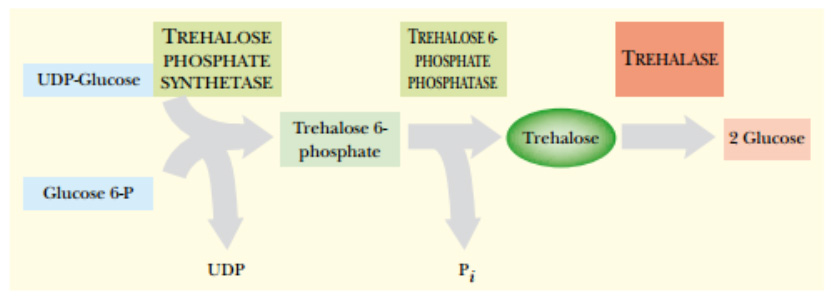Plants are highly adaptable and have many mechanisms to survive environmental stresses. Drought and high salinity of irrigation water are two stresses that pose problems in growing crop plants.
In drought-tolerant plants, fungi, and bacteria, the sugar trehalose protects the organism during times of stress. Trehalose is a nonreducing storage carbohydrate that has the capacity to absorb or release water molecules.
Two enzymes make trehalose: Trehalose phosphate synthase converts UDP-glucose and glucose 6-phosphate to trehalose 6- phosphate.
Next, trehalose 6-phosphate phosphatase removes the phosphate to make trehalose ( Fig. 1.0 ).
Another enzyme, trehalase , degrades the trehalose molecule into two glucose molecules.

FIGURE 1.0 Trehalose Synthetic and Degradative Pathways
Two enzymatic reactions make trehalose. First, trehalose phosphate synthetase converts UDPglucose plus glucose
6-phosphate into trehalose 6-phosphate. Next, trehalose-6-phosphate phosphatase removes the phosphate to make trehalose. Trehalose may be broken down into to glucose by trehalase.
To make rice more tolerant to high salinity or drought, a fusion gene encoding a protein with both trehalose phosphate synthase and trehalose 6-phosphate phosphatase activities was created and transformed into rice using the Ti plasmid of Agrobacterium . Two different constructs were tested that had the same fusion gene but different promoters. One construct had a stress-inducible promoter, and the other a light-inducible promoter. The insertion of these genes into rice made it much more tolerant to high salt concentrations and also to the lack of water. However, the same fusion gene with a constitutive promoter stunted plant growth. Thus, the expression pattern of transgenes can greatly change the outcome. These transgenic rice plants have not yet been used in the field, but show promise in finding ways to increase food production and quality in changing environments